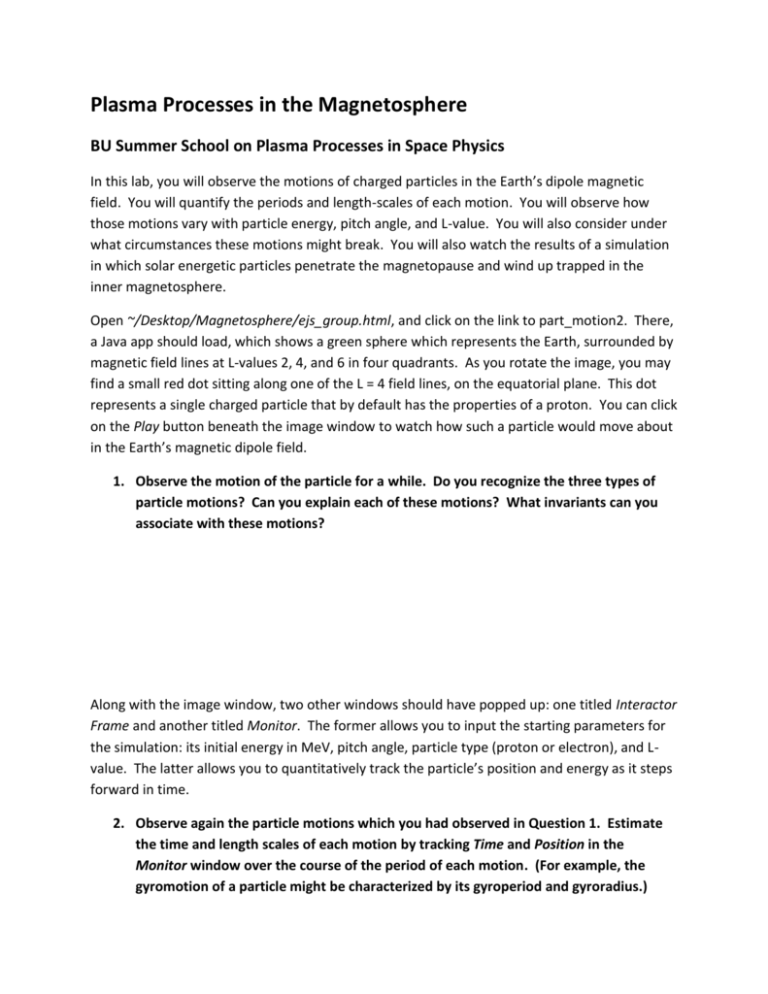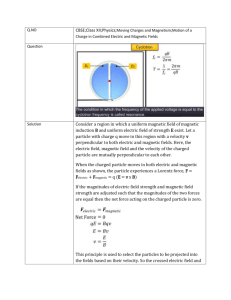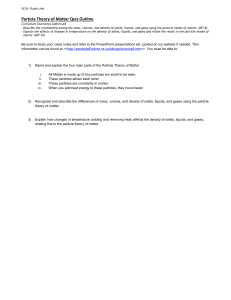Magnetosphere
advertisement

Plasma Processes in the Magnetosphere BU Summer School on Plasma Processes in Space Physics In this lab, you will observe the motions of charged particles in the Earth’s dipole magnetic field. You will quantify the periods and length-scales of each motion. You will observe how those motions vary with particle energy, pitch angle, and L-value. You will also consider under what circumstances these motions might break. You will also watch the results of a simulation in which solar energetic particles penetrate the magnetopause and wind up trapped in the inner magnetosphere. Open ~/Desktop/Magnetosphere/ejs_group.html, and click on the link to part_motion2. There, a Java app should load, which shows a green sphere which represents the Earth, surrounded by magnetic field lines at L-values 2, 4, and 6 in four quadrants. As you rotate the image, you may find a small red dot sitting along one of the L = 4 field lines, on the equatorial plane. This dot represents a single charged particle that by default has the properties of a proton. You can click on the Play button beneath the image window to watch how such a particle would move about in the Earth’s magnetic dipole field. 1. Observe the motion of the particle for a while. Do you recognize the three types of particle motions? Can you explain each of these motions? What invariants can you associate with these motions? Along with the image window, two other windows should have popped up: one titled Interactor Frame and another titled Monitor. The former allows you to input the starting parameters for the simulation: its initial energy in MeV, pitch angle, particle type (proton or electron), and Lvalue. The latter allows you to quantitatively track the particle’s position and energy as it steps forward in time. 2. Observe again the particle motions which you had observed in Question 1. Estimate the time and length scales of each motion by tracking Time and Position in the Monitor window over the course of the period of each motion. (For example, the gyromotion of a particle might be characterized by its gyroperiod and gyroradius.) Motion Time scale [s] Length scale [Re] 3. What is the local magnetic field that gives the gyroperiod that you found in Question 2? What is the value for the adiabatic invariant associated with that type of motion. Hint: Gyrofrequency 𝛀𝒄 = 𝒆𝑩 𝒎 . Feel free now to play around with the values in the Interactor Frame. To adjust any of these, press the Pause button the simulation, type in a new value for a given parameter, hit Enter, and then press Play again. 4. How do the frequencies and length scales of the three different motions change with the initial energy of the particle? With the pitch angle? (Try pitch angles of 0° and 90°.) With L-value? When you replace the proton with an electron? Hint: As you vary these parameters, the integration time-step will vary according to how hard it is to resolve the motions. So you will need to keep track of Time in the Monitor window, not on your watch. Note also that the integration method is not always so precise. Note, for example, that you might see the energy slowly increase in the Monitor window. The more quickly you see that energy increase, the greater the error. If you see it suddenly blowing up by leaps and bounds, you know not to believe the particle trajectory any more. You might see this happen for at least one case. Let us now consider how these motions might break down. 5. If the magnitude of the Earth’s dipole magnetic field can be modeled as 𝑩 ∝ 𝒓−𝟑 , write down a length scale for gradients in the magnetic field at L=4. Based on this number, is there an energy at which you would no longer expect ions to gyrate around the local magnetic field for pitch angle 60° and L = 4? (You may ignore relativistic effects for this exercise.) What happens to the proton when you give it this energy? Hint: Try comparing the gyroradius 𝝆 = 𝒎𝒗⊥ 𝒆𝑩 to the length scale of gradients in the magnetic field. Use the local 𝑩 that you calculated in Question 3. 6. Try out different energies until you have a sense of the energy threshold above which particles are no longer constrained to these three motions. (The energy you calculated in the previous question gives you an upper bound for that threshold.) What happens to this energy threshold as you increase the L-value? 7. What do you think will happen to this energy threshold if you replace the proton with an electron? Test out your hypothesis. Under what other circumstances might the guiding center approximation fail? 8. Did you find any conditions which broke the second adiabatic invariant? Theoretically, what particle parameters can break that invariant? 9. Due to the azimuthal symmetry in the dipole magnetic field used for this Java app, you won’t be able to break the third adiabatic invariant. In reality, this invariant is usually the first to break down. What breaks the azimuthal symmetry in the Earth’s magnetosphere? Now open the movie file geotrap.mpg. The movie shows test particles injected into a dynamic magnetosphere during a severe geomagnetic storm. The simulation is a global MHD simulation using the LFM (Lyon-Feder-Mobarry) code of a November 24, 2001 storm. The code used measured solar wind parameters from ACE (as you did yesterday) as its input, and consequently saw a strongly compressed magnetosphere due to a large solar wind density enhancement. A total of about 1.5 million particles were launched during a 5 minute interval of the MHD simulation. These particles represent a population of solar energetic particles (SEPs), high energy particles which were accelerated at a solar flare site or perhaps at a CME (coronal mass ejection) shock. The trajectories are tracked in 3-D, but are only shown in a 2-D cross section. 10. Which SEPs have access to the inner magnetosphere? Once they have penetrated the magnetopause, what do they do? Lastly, if you still have time, consider playing a little online flash game called Magneto Mini Golf. Go to http://www.spaceweathercenter.org/our_protective_shield/01/minigolf.html). This activity was developed as part of an outreach project, the Space Weather Center, designed for a general audience. You might even find that some of the questions in this lab are answered there. Have fun!






